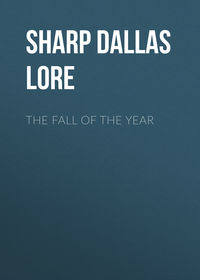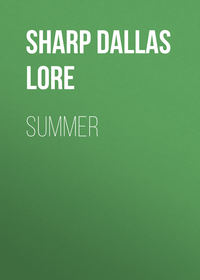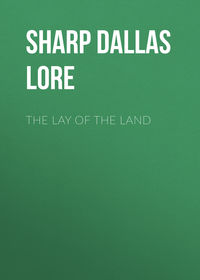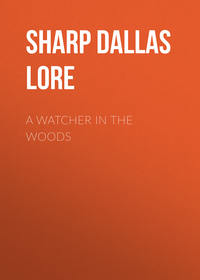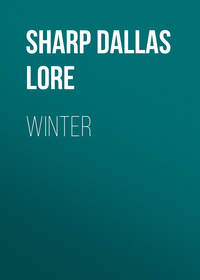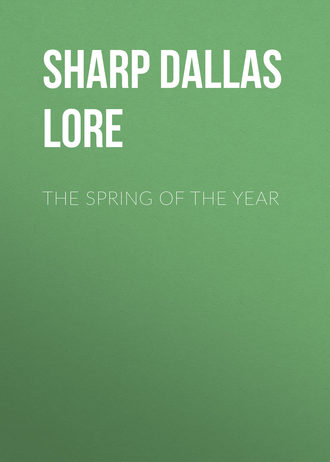 полная версия
полная версияThe Spring of the Year
Small wonder if they have never met! for this gray, squat, disk-toed little monster in the hole, or flattened on the bark of the tree like a patch of lichen, may well be one of the things that are hidden from even the sharp-eyed owl. It is always a source of fresh amazement, the way that this largest of the hylas, on the moss-marked rind of an old tree, can utterly blot himself out before your staring eyes.
The common toads and all the frogs have enemies enough, and it would seem from the comparative scarcity of the tree-toads that they must have enemies, too; but I do not know who they are. This scarcity of the tree-toads is something of a puzzle, and all the more to me, that, to my certain knowledge, this toad has lived in the old Baldwin tree, now, for five years. Perhaps he has been several toads, you say, not one; for who can tell one tree-toad from another? Nobody; and for that reason I made, some time ago, a simple experiment, in order to see how long a tree-toad might live, unprotected, in his own natural environment.
Upon moving into this house, about nine years ago, we found a tree-toad living in the big hickory by the porch. For the next three springs he reappeared, and all summer long we would find him, now on the tree, now on the porch, often on the railing and backed tight up against a post. Was he one or many? we asked. Then we marked him; and for the next four years we knew that he was himself alone. How many more years he might have lived in the hickory for us all to pet, I should like to know; but last summer, to our great sorrow, the gypsy moth killers, poking in the hole, hit our little friend and left him dead.
It was very wonderful to me, the instinct for home – the love for home, I should like to call it – that this humble little creature showed. Now, a toad is an amphibian to the zoölogist; an ugly gnome with a jeweled eye, to the poet; but to the naturalist, the lover of life for its own sake, who lives next door to his toad, who feeds him a fly or a fat grub now and then, who tickles him to sleep with a rose leaf, who waits as thirstily as the hilltop for him to call the summer rain, who knows his going to sleep for the winter, his waking up for the spring – to such a one, I say, a tree-toad means more than the jeweled eye and the strange amphibious habits.
This small tree-toad had a home, had it in a tree, too, – in a hickory tree, – this toad that dwelt by my house.
“East, west,Hame’s best,”croaked our tree-toad in a tremulous, plaintive song that wakened memories in the vague twilight of more old, unhappy, far-off things than any other voice I ever knew.
These two tree-toads could not have been induced to trade houses, the hickory for the apple, because a house to a toad means home, and a home is never in the market. There are many more houses in the land than homes. Most of us are only real-estate dealers. Many of us have never had a home; and none of us has ever had, perhaps, more than one, or could have – that home of our childhood.
This toad seemed to feel it all. Here in the hickory for four years (more nearly seven, I am sure) he lived, single and alone. He would go down to the meadow when the toads gathered there to lay their eggs; but back he would come, without mate or companion, to his tree. Stronger than love of kind, than love of mate, constant and dominant in his slow cold heart was his instinct for home.
If I go down to the orchard and bring up from an apple tree some other toad to dwell in the hole of the hickory, I shall fail. He might remain for the day, but not throughout the night, for with the gathering twilight there steals upon him an irresistible longing; and guided by it, as bee and pigeon and dog and man are guided, he makes his sure way back to his orchard home.
Would my toad of the Baldwin tree go back beyond the orchard, over the road, over the wide meadow, over to the old tree, half a mile away, if I brought him from there? We shall see. During the coming summer I shall mark him in some manner, and bringing him here to the hickory, I shall then watch the old apple tree yonder to see if he returns. It will be a hard, perilous journey. But his longing will not let him rest; and, guided by his mysterious sense of direction, – for that one place, – he will arrive, I am sure, or he will die on the way.
Suppose he never gets back? Only one toad less? A great deal more than that. There in the old Baldwin he has made his home for I don’t know how long, hunting over its world of branches in the summer, sleeping down in its deep holes during the winter – down under the chips and punk and castings, beneath the nest of the owls, it may be; for my toad in the hickory always buried himself so, down in the débris at the bottom of the hole, where, in a kind of cold storage, he preserved himself until thawed out by the spring.
I never pass the old apple in the summer but that I stop to pay my respects to the toad; nor in the winter that I do not pause and think of him asleep in there. He is no longer mere toad. He has passed into the Guardian Spirit of the tree, warring in the green leaf against worm and grub and slug, and in the dry leaf hiding himself, a heart of life, within the thin ribs, as if to save the old shell of a tree to another summer.
Often in the dusk, especially the summer dusk, I have gone over to sit at his feet and learn some of the things that my school-teachers and college professors did not teach me.
Seating myself comfortably at the foot of the tree, I wait. The toad comes forth to the edge of his hole above me, settles himself comfortably, and waits. And the lesson begins. The quiet of the summer evening steals out with the wood-shadows and softly covers the fields. We do not stir. An hour passes. We do not stir. Not to stir is the lesson – one of the primary lessons in this course with the toad.
The dusk thickens. The grasshoppers begin to strum; the owl slips out and drifts away; a whip-poor-will drops on the bare knoll near me, clucks and shouts and shouts again, his rapid repetition a thousand times repeated by the voices that call to one another down the long empty aisles of the swamp; a big moth whirs about my head and is gone; a bat flits squeaking past; a firefly blazes, is blotted out by the darkness, blazes again, and so passes, his tiny lantern flashing into a night that seems the darker for his quick, unsteady glow.
We do not stir. It is a hard lesson. By all my other teachers I had been taught every manner of stirring, and this strange exercise of being still takes me where my body is weakest, and puts me almost out of breath.
What! out of breath by keeping still? Yes, because I had been hurrying hither and thither, doing this and that – doing them so fast for so many years that I no longer understood how to sit down and keep still and do nothing inside of me as well as outside. Of course you know how to keep still, for you are children. And so perhaps you do not need to take lessons of teacher Toad. But I do, for I am grown up, and a man, with a world of things to do, a great many of which I do not need to do at all – if only I would let the toad teach me all he knows.
So, when I am tired, I will go over to the toad. I will sit at his feet, where time is nothing, and the worry of work even less. He has all time and no task. He sits out the hour silent, thinking – I know not what, nor need to know. So we will sit in silence, the toad and I, watching Altair burn along the shore of the horizon, and overhead Arcturus, and the rival fireflies flickering through the leaves of the apple tree. And as we watch, I shall have time to rest and to think. Perhaps I shall have a thought, a thought all my own, a rare thing for any one to have, and worth many an hour of waiting.
CHAPTER IV
A CHAPTER OF THINGS TO SEE THIS SPRING
Out of the multitude of sights, which twelve sights this spring shall I urge you to see? Why the twelve, of course, that I always look for most eagerly. And the first of these, I think, is the bluebird.
I“Have you seen a bluebird yet?” some friend will ask me, as March comes on. Or it will be, “I have seen my first bluebird!” as if seeing a first bluebird were something very wonderful and important. And so it is; for the sight of the first March bluebird is the last sight of winter and the first sight of spring. The brown of the fertile earth is on its breast, the blue of the summer sky is on its back, and in its voice is the clearest, sweetest of all invitations to come out of doors.
Where has he spent the winter? Look it up. What has brought him back so early? Guess at it. What does he say as he calls to you? Listen. What has John Burroughs written about him? Look it up and read.
IIYou must see the skunk-cabbage abloom in the swamp. You need not pick it and carry it home for the table – just see it. But be sure you see it. Get down and open the big purple-streaked spathe, as it spears the cold mud, and look at the “spadix” covered with its tiny but perfect flowers. Now wait a minute. The woods are still bare; ice may still be found on the northern slopes, while here before you, like a wedge splitting the frozen soil, like a spear cleaving through the earth from the other, the summer, side of the world, is this broad blade of life letting up almost the first cluster of the new spring’s flowers. Wait a moment longer and you may hear your first bumblebee, as he comes humming at the door of the cabbage for a taste of new honey and pollen.
IIIAmong the other early signs of spring, you should see a flock of red-winged blackbirds! And what a sight they are upon a snow-covered field! For often after their return it will snow again, when the brilliant, shining birds in black with their red epaulets make one of the most striking sights of the season.
IVAnother bird event that you should witness is the arrival of the migrating warblers. You will be out one of these early May days when there will be a stirring of small birds in the bushes at your side, in the tall trees over your head – everywhere! It is the warblers. You are in the tide of the tiny migrants – yellow warblers, pine warblers, myrtle warblers, black-throated green warblers – some of them on their way from South America to Labrador. You must be in the woods and see them as they come.
VYou should see the “spice-bush” (wild allspice or fever-bush or Benjamin-bush) in bloom in the damp March woods. And, besides that, you should see with your own eyes under some deep, dark forest trees the blue hepatica and on some bushy hillside the pink arbutus. (For fear I forget to tell you in the chapter of things to do, let me now say that you should take a day this spring and go “may-flowering.”)
VIThere are four nests that you should see this spring: a hummingbird’s nest, saddled upon the horizontal limb of some fruit or forest tree, and looking more like a wart on the limb than a nest; secondly, the nest, eggs rather, of a turtle buried in the soft sand along the margin of a pond or out in some cultivated field; thirdly, the nest of a sun-fish (pumpkin-seed) in the shallow water close up along the sandy shore of the pond; and fourthly, the nest of the red squirrel, made of fine stripped cedar bark, away up in the top of some tall pine tree! I mean by this that there are many other interesting nest-builders besides the birds. Of all the difficult nests to find, the hummingbird’s is the most difficult. When you find one, please write to me about it.
VIIYou should see a “spring peeper,” the tiny Pickering’s frog —if you can. The marsh and the meadows will be vocal with them, but one of the hardest things that you will try to do this spring will be to see the shrill little piper, as he plays his bagpipe in the rushes at your very feet. But hunt until you do see him. It will sharpen your eyes and steady your patience for finding other things.
VIIIYou should see the sun come up on a May morning. The dawn is always a wonderful sight, but never at other times attended with quite the glory, with quite the music, with quite the sweet fragrance, with quite the wonder of a morning in May. Don’t fail to see it. Don’t fail to rise with it. You will feel as if you had wings – something better even than wings.
IXYou should see a farmer ploughing in a large field – the long straight furrows of brown earth; the blackbirds following behind after worms; the rip of the ploughshare; the roll of the soil from the smooth mould-board – the wealth of it all. For in just such fields is the wealth of the world, and the health of it, too. Don’t miss the sight of the ploughing.
XGo again to the field, three weeks later, and see it all green with sprouting corn, or oats, or one of a score of crops. Then – but in “The Fall of the Year” I ask you to go once more and see that field all covered with shocks of ripened corn, shocks that are pitched up and down its long rows of corn-butts like a vast village of Indian tepees, each tepee full of golden corn.
XIYou should see, hanging from a hole in some old apple tree, a long thin snake-skin! It is the latch-string of the great crested flycatcher. Now why does this bird always use a snake-skin in his nest? and why does he usually leave it hanging loose outside the hole? Questions, these, for you to think about. And if you will look sharp, you will see in even the commonest things questions enough to keep you thinking as long as you live.
XIIYou should see a dandelion. A dandelion? Yes, a dandelion, “fringing the dusty road with harmless gold.” But that almost requires four eyes – two to see the dandelion and two more to see the gold – the two eyes in your head, and the two in your imagination. Do you really know how to see anything? Most persons have eyes, but only a few really see. This is because they cannot look hard and steadily at anything. The first great help to real seeing is to go into the woods knowing what you hope to see – seeing it in your eye, as we say, before you see it in the out-of-doors. No one would ever see a tree-toad on a mossy tree or a whip-poor-will among the fallen leaves who did not have tree-toads and whip-poor-wills in mind. Then, secondly, look at the thing hard until you see in it something peculiar, something different from anything like it that you ever saw before. Don’t dream in the woods; don’t expect the flowers to tell you their names or the wild things to come up and ask you to wait while they perform for you.
CHAPTER V
IF YOU HAD WINGS
If you had wings, why of course you would wear feathers instead of clothes, and you might be a crow! And then of course you would steal corn, and run the risk of getting three of your big wing feathers shot away.
All winter long, and occasionally during this spring, I have seen one of my little band of crows flying about with a big hole in his wing, – at least three of his large wing feathers gone, shot away probably last summer, – which causes him to fly with a list or limp, like an automobile with a flattened tire, or a ship with a shifted ballast.
Now for nearly a year that crow has been hobbling about on one whole and one half wing, trusting to luck to escape his enemies, until he can get three new feathers to take the places of those that are missing. “Well, why doesn’t he get them?” you ask. If you were that crow, how would you get them? Can a crow, by taking thought, add three new feathers to his wing?
Certainly not. That crow must wait until wing-feather season comes again, just as an apple tree must wait until apple-growing season comes to hang its boughs with luscious fruit. The crow has nothing to do with it. His wing feathers are supplied by Nature once a year (after the nesting-time), and if a crow loses any of them, even if right after the new feathers had been supplied, that crow will have to wait until the season for wing feathers comes around once more – if indeed he can wait and does not fall a prey to hawk or owl or the heavy odds of winter.
But Nature is not going to be hurried on that account, nor caused to change one jot or tittle from her wise and methodical course. The Bible says that the hairs of our heads are numbered. So are the feathers on a crow’s body. Nature knows just how many there are altogether; how many there are of each sort – primaries, secondaries, tertials, greater coverts, middle coverts, lesser coverts, and scapulars – in the wing; just how each sort is arranged; just when each sort is to be moulted and renewed. If Master Crow does not take care of his clothes, then he will have to go without until the time for a new suit comes; for Mother Nature won’t patch them up as your mother patches up yours.
But now this is what I want you to notice and think about: that just as an apple falls according to a great law of Nature, so a bird’s feathers fall according to a law of Nature. The moon is appointed for seasons; the sun knoweth his going down; and so light and insignificant a thing as a bird’s feather not only is appointed to grow in a certain place at a certain time, but also knoweth its falling off.
Nothing could look more haphazard, certainly, than the way a hen’s feathers seem to drop off at moulting time. The most forlorn, undone, abject creature about the farm is the half-moulted hen. There is one in the chicken-yard now, so nearly naked that she really is ashamed of herself, and so miserably helpless that she squats in a corner all night, unable to reach the low poles of the roost. It is a critical experience with the hen, this moulting of her feathers; and were it not for the protection of the yard it would be a fatal experience, so easily could she be captured. Nature seems to have no hand in the business at all; if she has, then what a mess she is making of it!
But pick up the hen, study the falling of the feathers carefully, and lo! here is law and order, every feather as important to Nature as a star, every quill as a planet, and the old white hen as mightily looked after by Nature as the round sphere of the universe!
Once a year, usually after the nesting-season, it seems a physical necessity for most birds to renew their plumage.
We get a new suit (some of us) because our old one wears out. That is the most apparent cause for the new annual suit of the birds. Yet with them, as with some of us, the feathers go out of fashion, and then the change of feathers is a mere matter of style, it seems.
For severe and methodical as Mother Nature must be (and what mother or teacher or ruler, who has great things to do and a multitude of little things to attend to, must not be severe and methodical?) – severe, I say, as Mother Nature must be in looking after her children’s clothes, she has for all that a real motherly heart, it seems.
For see how she looks after their wedding garments – giving to most of the birds a new suit, gay and gorgeous, especially to the bridegrooms, as if fine feathers did make a fine bird! Or does she do all of this to meet the fancy of the bride, as the scientists tell us? Whether so or not, it is a fact that among the birds it is the bridegroom who is adorned for his wife, and sometimes the fine feathers come by a special moult – an extra suit for him!
Take Bobolink, for instance. He has two complete moults a year, two new suits, one of them his wedding suit. Now, as I write, I hear him singing over the meadow – a jet-black, white, and cream-buff lover, most strikingly adorned. His wife, down in the grass, looks as little like him as a sparrow looks like a blackbird. But after the breeding-season he will moult again, changing color so completely that he and his wife and children will all look alike, all like sparrows, and will even lose their names, flying south now under the name of “reed-birds.”
Bobolink passes the winter in Brazil; and in the spring, just before the long northward journey begins, he lays aside his fall traveling clothes and puts on his gay wedding garments and starts north for his bride. But you would hardly know he was so dressed, to look at him; for, strangely enough, he is not black and white, but still colored like a sparrow, as he was in the fall. Apparently he is. Look at him more closely, however, and you will find that the brownish-yellow color is all caused by a veil of fine fringes hanging from the edges of the feathers. The bridegroom wearing the wedding veil? Yes! Underneath is the black and white and cream-buff suit. He starts northward; and, by the time he reaches Massachusetts, the fringe veil is worn off and the black and white bobolink appears. Specimens taken after their arrival here still show traces of the brownish-yellow veil.
Many birds do not have this early spring moult at all; and with most of those that do, the great wing feathers are not then renewed as are bobolink’s, but only at the annual moult after the nesting is done. The great feathers of the wings are, as you know, the most important feathers a bird has; and the shedding of them is so serious a matter that Nature has come to make the change according to the habits and needs of the birds. With most birds the body feathers begin to go first, then the wing feathers, and last those of the tail. But the shedding of the wing feathers is a very slow and carefully regulated process.
In the wild geese and other water birds the wing feathers drop out with the feathers of the body, and go so nearly together that the birds really cannot fly. On land you could catch the birds with your hands. But they keep near or on the water and thus escape, though times have been when it was necessary to protect them at this season by special laws; for bands of men would go into their nesting-marshes and kill them with clubs by hundreds!
The shedding of the feathers brings many risks to the birds; but Nature leaves none of her children utterly helpless. The geese at this time cannot fly because their feathers are gone; but they can swim, and so get away from most of their natural enemies. On the other hand, the hawks that hunt by wing, and must have wings always in good feather, or else perish, lose their feathers so slowly that they never feel their loss. It takes a hawk nearly a year to get a complete change of wing feathers, one or two dropping out from each wing at a time, at long intervals apart.
Then here is the gosling, that goes six weeks in down, before it gets its first feathers, which it sheds within a few weeks, in the fall. Whereas the young quail is born with quills so far grown that it is able to fly almost as soon as it is hatched. These are real mature feathers; but the bird is young and soon outgrows these first flight feathers, so they are quickly lost and new ones come. This goes on till fall, several moults occurring the first summer to meet the increasing weight of the little quail’s growing body.
I said that Nature was severe and methodical, and so she is, where she needs to be, so severe that you are glad, perhaps, that you are not a crow. But Nature, like every wise mother, is severe only where she needs to be. A crow’s wing feathers are vastly important to him. Let him then take care of them, for they are the best feathers made and are put in to stay a year. But a crow’s tail feathers are not so vastly important to him; he could get on, if, like the rabbit in the old song, he had no tail at all.
In most birds the tail is a kind of balance or steering-gear, and not of equal importance with the wings. Nature, consequently, seems to have attached less importance to the feathers of the tail. They are not so firmly set, nor are they of the same quality or kind; for, unlike the wing feathers, if a tail feather is lost through accident, it is made good, no matter when. How do you explain that? Do you think I believe that old story of the birds roosting with their tails out, so that, because of generations of lost tails, those feathers now grow expecting to be plucked by some enemy, and therefore have only a temporary hold?
The normal, natural way, of course, is to replace a lost feather with a new one as soon as possible. But, in order to give extra strength to the wing feathers, Nature has found it necessary to check their frequent change; and so complete is the check that the annual moult is required to replace a single one. The Japanese have discovered the secret of this check, and are able by it to keep certain feathers in the tails of their cocks growing until they reach the enormous length of ten to twelve feet.
My crow, it seems, lost his three feathers last summer just after his annual moult; the three broken shafts he carries still in his wing, and must continue to carry, as the stars must continue their courses, until those three feathers have rounded out their cycle to the annual moult. The universe of stars and feathers is a universe of law, of order, and of reason.


